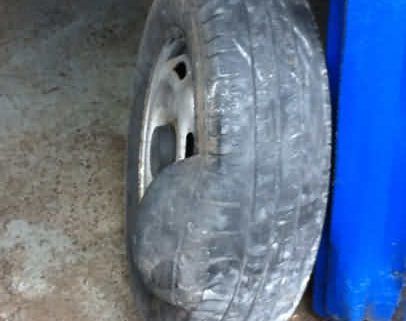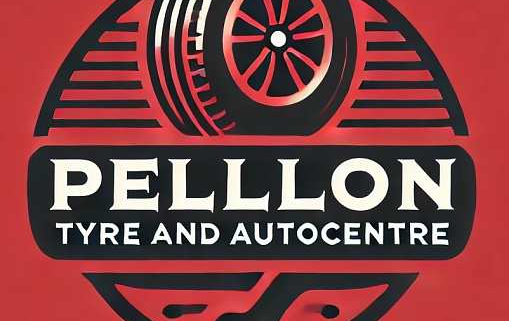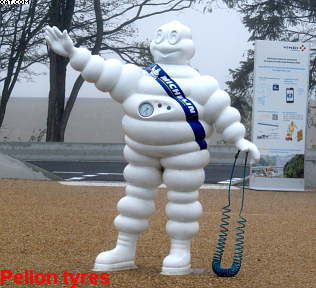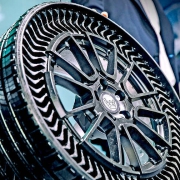What is Tyre Separation
Table of Contents
What is Tyre Separation

What is Tyre Separation
Many people will recognise tyre separation in the form of a bubble or bulge somewhere on one of their tyres. There can be many reasons for this. Back in the good old days, when I was a young tyre fitter, separation was a more common site on our customers tyres. At the time, I must confess that we did not know the reason for this and just took it as the “statusquo.”
Radial Tyres were relativly new in the dark old days
Subsequently, x ply tyres were the most common type of tyres when I first went into the tyre industry. These were followed briefly by bias belted tyres that were becoming more popular in the United States. American tyre companies were always trying to produce a tyre that could cope with the suspensions of the huge American cars that were produced in those days.
Radials were tried and tested here in Europe on very different types of car construction. Importantly, a new type of tyre was being developed by the Michelin tyre company in France. The first type I remember well, the Michelin X tyres were fitted to imported Citroens, primarily the first Citroen 2CV models that were imported into the UK.
I remember that these tyres looked very strange, they were very thin and didnt look like they were up to the job. However, they were to prove us very long and soon became renowned for there high mileage. Especially when compared to Xply tyres.
Michelin patented the secret steel belt that they used in the manufacture of these new types of tyres. Meanwhile, all the other tyre makers, such as Goodyear and Firestone, were trying to catch up by developing their own styles of radial tyres.
Problems started to appear ? What is Tyre Separation
As the radial tyres were becoming more popular, problems started to appear. This is where the link to this post about tyre sepraration comes into play. Michelins secret development of the special steel belt was the secret behind the new type of steel radial tyres. Other tyre manufacturers struggled to find a similar type of steel to make their tyres with.
Hence problems started to arise. I remember Firestone in particular. Consequently, we were presented with Firstone tyres becoming out of shape or developing bubbles on all parts of the tyres. This was known as “separation”. In this instance, it was due to the steel belts oxidising (rusting).
This would happen when a tyre had a puncture allowing water to come into contact with the steel belt, causing it to rust, and the resulting gases would cause the tyres to become out of shape. This could also occur if the tyre was subject to any type of condensation in the air at the time of manufacture.
Michelin were probably the first tyre company to impose strict manufacturing processes in their tyre factories. Also not known at the time, Michelin used special steel wire that was coated with a type of brass before used to make the steel radial tyres. This is where other companies failed and problems started to appear.
Textile radials stopped the rot of tyre separation in the UK
Textile radials were also developed by using many strong materials, such as nylon, rayon, or polyester. Each tyre company used their own choice of materials and claimed that their tyres were the best. However, steel radials still produced the best results.
Dunlop tyres claimed that by using textiles, a much less abrasive material, their tyres were a much softer ride. The Jaguar company installed the Dunlop textile radials on many of their models of sports luxury cars as evidence for this. However, balncing problems haunted Dunlop, but that’s another story.
Michelin eventually decided to release their secret steel coating formulae to the other tyre companies. This helped the other tyre companies to compete on a level playing field, and things such as “separation” problems decreased dramaticaly.
The Quiet Risk: Recognising Tyre Separation and Its Origins- What is Tyre Separation
The unsung heroes of our cars are frequently the tyres. They quietly bear the burden of every bump, curb, and uneven road while ensuring our safety while we travel. Tyre separation is a lesser-known problem that can transform your trustworthy tyres into a major safety risk. Even though this situation is uncommon, if it is allowed to continue, it could be deadly. Now let’s explore the definition of tyre separation, its causes, and prevention methods.
Tyre separation: What is it? What is Tyre Separation
When a tyre’s many layers begin to separate, tyre separation happens. The steel belts, inside fabric layers, and exterior rubber are the layers that make up a modern tyre. During the manufacturing process, a bond holds these layers together, but as that bond weakens or breaks, the layers start to separate. This may result in diminished performance, surface bulges on the tyre, and, in the worst situations, an unexpected blowout.
Reasons Why Tyres Separate-What is Tyre Separation
Tyre separation can result from a number of things, including operator error and manufacturing flaws. Below is a summary of the most frequent causes:
1. Defects in Manufacturing–What is Tyre Separation
Manufacturing errors can still happen, despite the use of contemporary quality control procedures. There are instances when a tyre leaves the manufacturer with inadequate layer bonding, which can later cause separation. It’s frequently too late for a car owner to notice this, which is why routine tyre checkups are so important.
2. Inadequate Tyre Maintenance–What is Tyre Separation
Poor repair work can have disastrous effects on your tyres. The structural integrity of the tyre may be compromised if a puncture is not correctly fixed. When a puncture is repaired with a plug rather than a patch, for instance, moisture and air may seep between the layers and eventually cause separation.
3. Overburdening–What is Tyre Separation
The maximum load rating of a tyre refers to the maximum weight that it can support securely. When this limit is exceeded, the tires are subjected to severe stress, especially on the inside layers. The layers may weaken and extend as a result of overloading, causing separation. With bigger cars like vans and RVs, where the desire to overload is stronger, this is particularly risky.
4. Inadequate Inflation–What is Tyre Separation
The longevity and safety of your tyres depend on maintaining proper air pressure in them. More of the tire’s surface comes into contact with the road when the tyre is underinflated, which increases heat and friction. The additional heat may weaken the link between the layers, allowing them to separate. On the other hand, excessive inflation can result in uneven tyre wear and stress on the edges, which may cause related problems.
5. Damage from Impact–What is Tyre Separation
It is possible for your tyres to sustain instant, possibly undetectable damage when you hit a pothole, curb, or other road hazard. The impact may result in a small internal split that gradually manifests and eventually becomes more obvious. The damage frequently doesn’t show up right away, but eventually the weakening of the link between the layers may lead to separation.
6. Tyre Ageing-What is Tyre Separation
Tyres wear down over time. The components of the tyre may deteriorate with time, particularly if they are subjected to adverse environments like intense heat, direct sunshine, or chemicals. The rubber may become brittle with age and the links between the layers may deteriorate, increasing the likelihood of separation. For this reason, even if your tyres seem to have plenty of tread left, it’s normally advised to change them every 6 to 10 years.
Tyre Separation Prevention
Although tyre separation is a dangerous situation, there are things you may do to lessen the chance:
Ongoing Examinations:
Develop the practice of routinely inspecting your tyres for deterioration, including cracks, bulges, and uneven wear. Immediately have it checked out by a professional if you detect anything strange.
Adequate Inflation:
Make sure the pressure in your tyres is as the manufacturer has recommended. This information is available on the tyre placard located inside the driver’s door or in the handbook for your automobile.
Avoid Overloading:
Recognise the maximum load that your car can carry and don’t go above it. If you frequently transport large items, you might want to upgrade to tires with a greater load rating.
Cautionary Driving:
Aim to steer clear of potholes, curbs, and other hazards that may result in impact damage. When approaching them, try to move as slowly as you can if you can’t avoid them.
Install New Tyres:
Age can have its effects, even if your tyres appear to be in good condition. Replace old tyres before they become dangerous to avoid pushing your luck.
Expert Repair Services:
Make sure a skilled technician fixes your punctured tyre correctly. Steer clear of fast solutions that could damage the tire’s integrity.
Concluding Remarks
Although tyre separation may not be the first thing that comes to mind, being aware of the risks and taking precautions can save you a great deal of hassle and possibly even your life. You can make sure that your tyres will continue to dependablely carry you for miles on end by maintaining them. Make sure your tyres are suitable for the job, whether you’re driving on the motorway or just stopping by the store here in Halifax, UK. Ultimately, their safety depends on them.
- Citroen C3 For Starting Problem
- Punctured Tyre
- Bridgestone Run Flat
- Fiat Panda Corroded Rear Axle
- Peugoet 207 Trac Rod Ends




